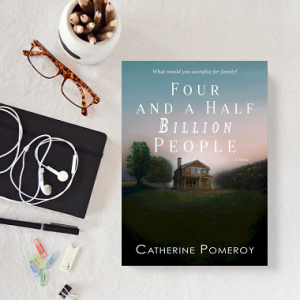Reading Like A Writer
Reading Like a Writer
by Catherine Pomeroy
 We’ve all heard the advice: read like a writer. Read everything you can devour. Read outside your genre. It’ll be good for you, they say, kind of like eating your Brussels sprouts. You’ll expand your vocabulary, pick up nuances from the literary masters—although for heaven’s sake, keep your writing simple, draw in the reader quickly through action, build tension by figuring out what your characters want but not letting them have it—and, above all, never use adjectives (sorry, Stephen King).
We’ve all heard the advice: read like a writer. Read everything you can devour. Read outside your genre. It’ll be good for you, they say, kind of like eating your Brussels sprouts. You’ll expand your vocabulary, pick up nuances from the literary masters—although for heaven’s sake, keep your writing simple, draw in the reader quickly through action, build tension by figuring out what your characters want but not letting them have it—and, above all, never use adjectives (sorry, Stephen King).
I try. I really do.
And reading has influenced my writing. As a reader, my eyes gloss over lengthy and tortuously (sorry again, Stephen) detailed descriptions. But Celeste Ng’s Little Fires Everywhere drew me in to the vibe of the Cleveland suburb of Shaker Heights, setting the scene seamlessly with the pace of the story. It inspired me to go back and add layers to the feel of the small-town southern Ohio setting of my second novel, Four and a Half Billion People. I wanted that sense of place. I had down images of my grandfather’s Stetson and coal miner overalls, the whistle of the afternoon train, thick humidity, and aged copies of Readers Digest on the side table, but to all that I added the triple harp in the Welsh heritage museum, ancient Indian mounds, and the rattle of granny’s china in the cabinet.
For character development, Homer Hickam’s character in October Sky captured the adolescent yearning to see a larger world, which Homer accomplished through science and math. This inspired my writing of the character James, an awkward teenager with gifted mathematical skills who writes letters to an unknown bicycle club at a post office box ad in the back of a magazine as a portal to something greater.
Jodi Picoult’s novels dig beyond stereotypes into social justice issues that allow the reader to reach a higher level of understanding through a well-told story. Reading Jodi’s novels helped me conjure the heartache of drug addiction and lost children that made up the character Brandy in my first novel The Gulch Jumpers.
Nonfiction can do this too. It’s one thing to learn about the Holocaust in school, but not until I read Tilar Mazzeo’s Irena’s Children and delved into how desperate parents in the Warsaw Ghetto cast their toddlers into the sewer system to try to save their lives, did I truly understand and truly feel the horror.
We read for feeling. Liane Moriaty’s novels, and Elena Ferrante’s Neapolitan novels (start with My Brilliant Friend), capture the chatty woman-to-woman banter of friendship that feels as good as a chocolate-strawberry banana split. Patricia Harmon’s midwife novels are great tales of healthcare in Appalachia, but also bathe us in unabashed sentimentality and nostalgia for simpler things. And who doesn’t want that? Have the courage to go corny, I say. The world can be a hard place, why not give your reader an emotional hug and let them read for comfort and a soft landing?
Donna Tartt’s The Goldfinch’s depiction of a largely abandoned mini-mansion development of unsold homes in Las Vegas left me with a strong feeling of the desperation of that stark landscape. I could picture tumbleweeds rolling down the empty streets. That mental picture inspired the sparsely populated exurbia setting of my current WIP. And, for action that sucks you in right from the start, there can be no argument with Andy Weir’s Project Hail Mary.
For both writer and reader, at some point in the story, there is that “click” – your brain slips into a state of flow. For the writer, the words come easily and the story spills. For the reader, the book becomes a page-turner that will keep you up late and can’t be put down. For me, I may start a book with intention to “read like a writer” and analytically dissect the arc of the story, the character development, the chapter length. But then that magic happens when the mind of the reader syncs with the mind of the writer. And then, without even knowing it, I’m lost in the story and completely immersed. Not until I come up for air when the tale has concluded is there that disorientating awareness that I’ve been on a journey and the story has changed me.
And when you do come up for air, after allowing that internal “damn, I wish I could write like that!” moment, go back. Read it again. Do your analytical homework. Keep a notebook nearby and jot down notes and observations, phrases or particular words that speak to you. What about the title or cover prompted you to pick it up in the first place? Strive for enough self-awareness to skim above the emotion so you can do the writer’s work of studying the technique that delivered that emotion.
So sure, strive to read like a writer. But more importantly, read like a reader. To understand. To feel. To alleviate human loneliness. Because after all, reading a good book is a vacation in your head—the kind of vacation where you pause to reflect, learn, talk to new people, simultaneously crave and fear the adventure, and realize you are not alone. Read for joy. It will make you a better writer and more importantly, a better person.
—
Biography – author Catherine Pomeroy
Catherine Pomeroy is a writer and attorney who lives with her husband in Ohio. When she’s not busy practicing law, Catherine is an avid cyclist who loves travel and exploring bicycle trails. She is the author of two novels, The Gulch Jumpers and her most recent release, Four and a Half Billion People. (No Bad Books Press). Music, love of family, social justice, and Appalachian culture inspire her writing.
Please visit Catherine’s website at http://catherinepomeroy.com/ and follow her on Facebook at http://www.facebook.com/catpomeroyauthor and Twitter @catpomeroy.
FOUR AND A HALF BILLION PEOPLE
 What would you sacrifice for family?
What would you sacrifice for family?
Jorie’s respectful life as “justa hairdresser” screeches to a halt when her eldest son, James, is accused of mowing down the mayor’s husband. It’s 1978 and the townsfolk are obsessed with James’ trial, convinced of his guilt. All they see is his pacing, counting, and obsession with a 200-mile bicycle tour he has no hope of riding. They don’t understand how he sees equations as colors, tastes emotions, and smells sounds. But James has a secret, one he won’t tell, one worth going to jail for.
A handsome lawyer and a mysterious bicycle club come to the rescue as Jorie struggles to hold her family together through the courtroom drama. Numbers can’t always predict the result when secrets, lies and loyalty push the question of how far we will go to protect the ones we love.
If you liked Jodi Picoult’s Nineteen Minutes, try Four and a Half Billion People!
BUY HERE
Category: How To and Tips






























